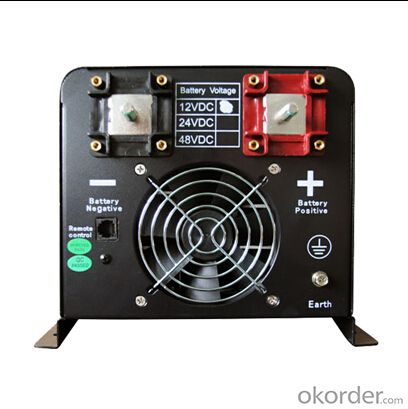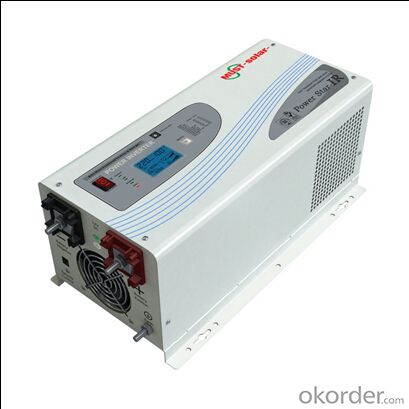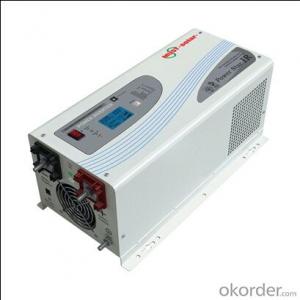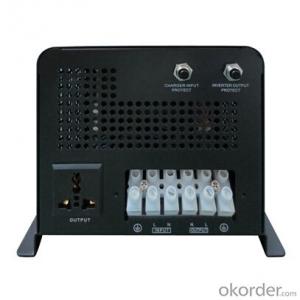Off-Grid Low Frequency PV Inverter EP3200 Series 1KW-3KW
- Loading Port:
- China main port
- Payment Terms:
- TT or LC
- Min Order Qty:
- 30000 watt
- Supply Capability:
- 18000000 watt/month
OKorder Service Pledge
OKorder Financial Service
You Might Also Like
1. Structure of Off-Grid Low Frequency PV Inverter Description
A solar inverter, or PV inverter, or Solar converter, converts the variable direct current (DC) output of a photovoltaic (PV) solar panel into a
utility frequency alternating current (AC) that can be fed into a commercial electrical grid or used by a local, off-grid electrical network. It is a
critical BOS–component in a photovoltaic system, allowing the use of ordinary AC-powered equipment. Solar inverters have special
functions adapted for use with photovoltaic arrays, including maximum power point tracking and anti-islanding protection..
2. Main Features of the Off-Grid Low Frequency PV Inverter
• High overload ability of our EP3200 charger is up to 300% rated power
• EP3200 pure sine wave inverter adopts low quiescent current, and power saver mode to reduce power consumption to 3W
• It can extract max• power from various batteries with different protections, and low voltage trip can be selected (10V/10. 5V/11V)
• Uses PFC (power factor correction) for charger, which has less power consumption than conventional units.
• It has 10s delay before transfer when AC resumes, and overload protection when our APC pure sine wave inverter equips with generator
• 10ms typical transfer time between battery and AC, which guarantees power continuity of EP3200 charger. Uses selectable input AC
voltage (185-265V or 155-255V) for different kinds of loads
• Our EP3200 charger allows start up and through power with depleted batteries. Its powerful charge rate up to 70Amp
• It can offer 3-step intelligent battery charging, and equipped with 6 preset battery type selector for totally flat batteries
• LCD status display, battery/AC priority switch, RS232 communication port are available for our EP3200 pure sine wave inverter, it also has
17 alarms/warnings for easier operation and trouble-shooting, and ability to switch the unit on/off. In addition, select/deselect power saver
mode can be used too
3. Off-Grid Low Frequency PV Inverter Images




4. Off-Grid Low Frequency PV Inverter Specification
Rated Capacity | 1000W | 1500W | 2000W | 3000W |
Efficiency | >90% | |||
Input | ||||
Model | 120v Models | 230v Models | ||
Nominal Voltage | 100V/110V/115V/120V Selectable | 200V/220V/230V/240V Selectable | ||
Output | ||||
Rated Power | 1000W | 1500W | 2000W | 3000W |
Output Voltage | 100V/110V/115V/120V Selectable | 200V/220V/230V/240V Selectable | ||
Voltage Waveform | Pure Sine Wave | |||
Crest Factor | 3:01 | |||
Regulation(Nominal) | ±10% Typical Of Nominal Voltage | |||
Transfer Time | Transfer Time : AC To DC : 10ms (Typical) | |||
Transfer Time : DC To AC : 10ms(Typical ) | ||||
Max Bypass Overload Current | 30A | |||
Input | ||||
Nominal Voltage | DC12V/24V | DC12V/24V | DC12V/24V | DC24V/48V |
Over Current Protection | By Re-Settable Over Current Protector | |||
Output | ||||
Nominal Input Voltage | 230Vac | |||
Input Voltage Range | 185~265Vac | |||
Nominal Charge Current | 35amp-70amp | |||
Charger Short | Circuit Breaker | |||
Circuit Protection | ||||
Over Charge | Bat• V ≥ 15• 7Vdc/31• 4Vdc/62• 8Vdc | |||
Protection | Beeps 0• 5s Every 1s & Fault After 60s | |||
Battery Type | Lead-Acid 12Ah ~ 250Ah | |||
Typical Backup Time | No Limit, Depend on external battery | |||
Average Charging Current | 35A/20A | 45A/30A | 65A/35A | 75A/30A |
Battery voltage Option | ||||
Options 7 | Battery low trip to bypass 11v , high trip to battery 14v | |||
Options 8 | Battery low trip to bypass 10• 5v , high trip to battery 13• 5v | |||
Options 9 | Battery low trip to bypass 10v , high trip to battery 13v | |||
Communications & Management | ||||
Control Panel | LCD/LED Option | |||
Audible Alarm | Alarm On Battery:Low Battery & Battery Over Voltage | |||
Alarm On Abnormal Operation: | ||||
Over Load, Short-Circuit, & Over Heat | ||||
Environment and Safe | ||||
Operating Temperature | 0℃ To 40℃ (32℉ To 104℉) | |||
Transit/Storage Temperature | -15℃ To 60℃ | |||
Audible Noise | 60 Dba Max at 1m | |||
Quality Control System | ISO 9001,CE,FCC | |||
Physical | ||||
Dimensions: (H×D×W) | 570*320*315mm | |||
G• W (Kg) | 19 | 19 | 22.5 | 27.5 |
Packing | Export Carton For Each Unit Per Carton | |||
5. FAQ of Off-Grid Low Frequency PV Inverter
Q1 What is the difference between inverter and Off-Grid Low Frequency PV Inverter?
A1Inverter only has AC inpput, but Off-Grid Low Frequency PV Inverter both connect to AC input and solar panel, it saves more power.
Q2 What is the difference between MPPT&PWM?
A2MPPT has higher efficiency, it can track the max power point and won't waste energy.
Q3 What is the waranty of product?
A3 12 months.
- Q:What is maximum power point tracking (MPPT) in a solar inverter?
- Maximum Power Point Tracking (MPPT) in a solar inverter is a technique used to optimize the energy output of a solar panel system by continuously tracking and adjusting the operating point of the panels to ensure they are operating at their maximum power point. This is achieved by dynamically adjusting the voltage and current levels to match the changing environmental conditions and load requirements, allowing the solar panels to produce the maximum amount of power available at any given time.
- Q:What is the role of a solar inverter in fault ride-through capability?
- The role of a solar inverter in fault ride-through capability is to ensure that the solar power system remains operational and stable during grid faults or disturbances. The inverter is responsible for detecting fault conditions and adjusting its output to mitigate the impact of the fault on the system. By providing fault ride-through capability, the solar inverter helps maintain grid stability and ensures continuous power supply from the solar panels even in the presence of faults.
- Q:What are the advantages of using a solar inverter?
- There are several advantages of using a solar inverter. Firstly, solar inverters convert the direct current (DC) generated by solar panels into alternating current (AC), which is the type of electricity used in most homes and businesses. This allows for the seamless integration of solar power into the existing electrical grid. Secondly, solar inverters optimize the performance of solar panels by constantly monitoring and adjusting the voltage and current levels. This ensures that the panels are operating at their maximum power output, resulting in higher energy efficiency and increased electricity production. Moreover, solar inverters enable net metering, which allows excess solar energy to be fed back into the grid, effectively spinning the electricity meter backward. This can lead to significant savings on electricity bills or even generate income through feed-in tariffs. Additionally, solar inverters offer advanced monitoring capabilities, allowing homeowners and system operators to track the energy production and performance of their solar systems in real-time. This data enables better system maintenance, troubleshooting, and optimization. Lastly, solar inverters contribute to a cleaner and more sustainable energy future by reducing dependence on fossil fuels and minimizing greenhouse gas emissions. They play a crucial role in harnessing the power of the sun to generate clean, renewable energy.
- Q:Why is a solar inverter necessary in a solar power system?
- A solar inverter is necessary in a solar power system because it is responsible for converting the direct current (DC) generated by the solar panels into alternating current (AC) that can be used to power household appliances and be fed back into the electrical grid.
- Q:Can a solar inverter be connected to a battery storage system?
- Yes, a solar inverter can be connected to a battery storage system. This allows excess solar energy generated during the day to be stored in the batteries and used later when there is no sunlight, providing a reliable source of power.
- Q:Can a solar inverter be repaired or serviced?
- Yes, a solar inverter can be repaired or serviced. Inverters are complex electronic devices that can experience faults or malfunctions over time. Depending on the issue, a qualified technician can diagnose and repair the inverter, replacing faulty components if necessary. Regular maintenance and servicing can also help identify potential problems and ensure optimal performance of the solar inverter.
- Q:Are there any government incentives available for solar inverters?
- Yes, there are government incentives available for solar inverters. These incentives vary by country and region, but often include tax credits, grants, and rebates to encourage the adoption of solar energy. It is recommended to check with local authorities or consult a solar energy professional to determine the specific incentives available in a particular area.
- Q:What is the maximum DC input current that a solar inverter can handle?
- The maximum DC input current that a solar inverter can handle varies depending on the specific model and capacity of the inverter. It is typically mentioned in the product specifications and can range from a few amps to several hundred amps.
- Q:Are there any limitations on the number of solar panels that can be connected to a single inverter?
- The number of solar panels that can be connected to a single inverter is limited. Various factors, such as the inverter's power rating, the voltage and current ratings of the panels, and the system's configuration, determine the maximum number of panels that can be connected. In general, the inverter should be able to handle the combined power output of all the connected panels. If the panels generate more power than the inverter can handle, it can lead to inefficiencies, reduced performance, or damage to the inverter. Moreover, the panels' voltage and current ratings should be within the acceptable range of the inverter. If the panels exceed the inverter's safe limits, it can lead to overloading or malfunctioning. Furthermore, the configuration of the panels is also important in determining the limitations. Panels can be connected in series or parallel, each with its own requirements and limitations. The inverter must be compatible with the specific configuration used. To ensure proper functioning and optimal performance, it is advisable to refer to the manufacturer's guidelines and specifications for both the solar panels and the inverter. These guidelines provide information on the maximum number of panels that can be connected to a single inverter, as well as any other specific limitations or requirements to consider.
- Q:Can a solar inverter be used with a remote monitoring system?
- Yes, a solar inverter can be used with a remote monitoring system. Remote monitoring systems are designed to monitor and control the performance of solar inverters from a remote location. This allows users to track and analyze the solar energy production, detect any issues or faults in the inverter, and make necessary adjustments for optimal performance.
1. Manufacturer Overview |
|
|---|---|
| Location | |
| Year Established | |
| Annual Output Value | |
| Main Markets | |
| Company Certifications | |
2. Manufacturer Certificates |
|
|---|---|
| a) Certification Name | |
| Range | |
| Reference | |
| Validity Period | |
3. Manufacturer Capability |
|
|---|---|
| a)Trade Capacity | |
| Nearest Port | |
| Export Percentage | |
| No.of Employees in Trade Department | |
| Language Spoken: | |
| b)Factory Information | |
| Factory Size: | |
| No. of Production Lines | |
| Contract Manufacturing | |
| Product Price Range | |
Send your message to us
Off-Grid Low Frequency PV Inverter EP3200 Series 1KW-3KW
- Loading Port:
- China main port
- Payment Terms:
- TT or LC
- Min Order Qty:
- 30000 watt
- Supply Capability:
- 18000000 watt/month
OKorder Service Pledge
OKorder Financial Service
Similar products
New products
Hot products
Hot Searches
Related keywords





























